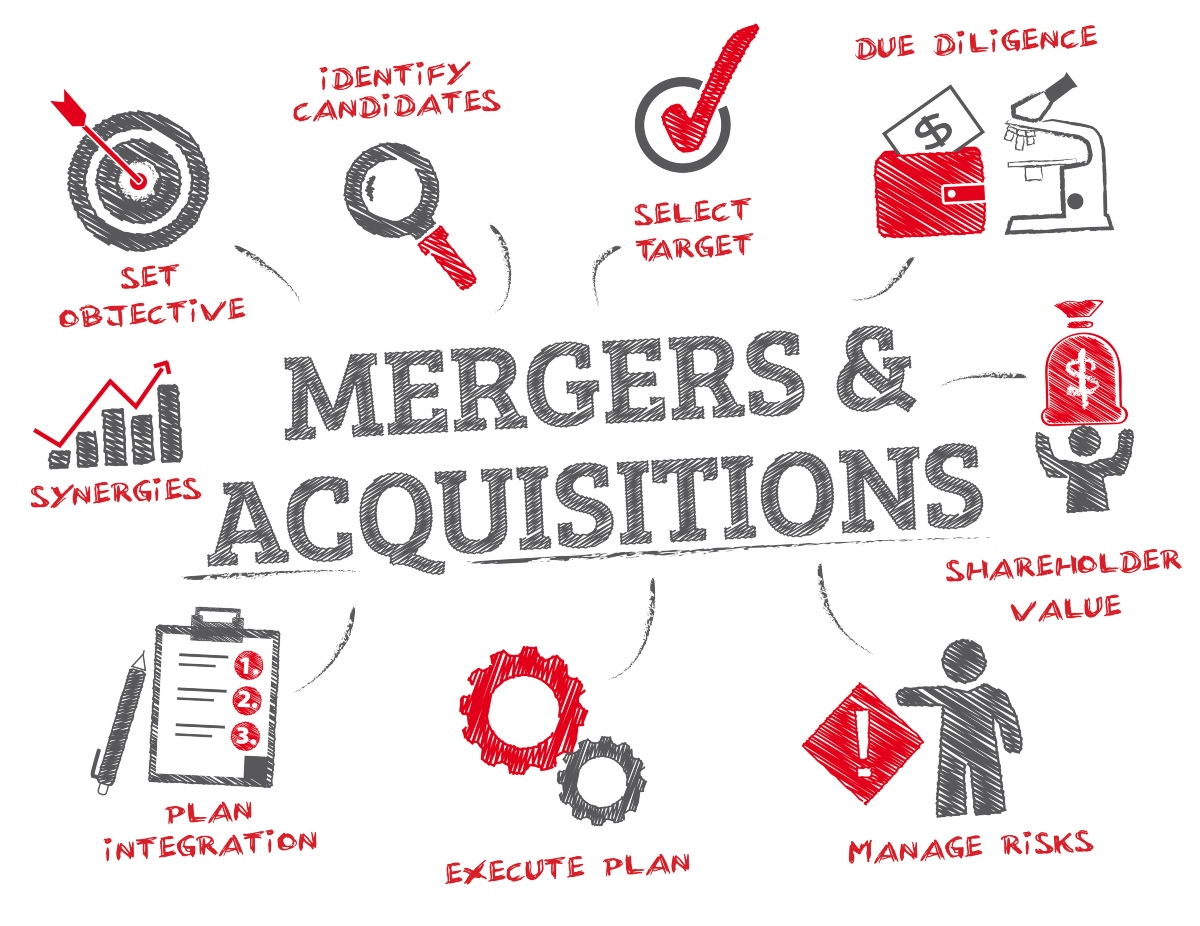Mergers and acquisitions are two different things. Mergers happen when one company acquires another company, whereas an acquisition happens when a company buys the whole company outright.

They’re both similar in that they involve a company buying out another company, but mergers tend to be more complicated because of the need to merge the two companies together into one entity with shared ownership.
If a company acquires another company, it’s generally just buying up all their shares and working with the existing management. This is less complicated for both companies because they have to work together only in terms of completing transactions regarding money or property that was bought out by the purchaser company.
An acquisition tends to be more expensive initially but it’s generally more profitable in the long run.
Mergers are complicated because there is a lot of legal work involved with negotiating company terms, while acquisitions involve less negotiation since it only involves buying out property or company shares rather than merging companies together.
If you’re thinking about pursuing either mergers or acquisitions for your company, be sure to consult company advisors who work in finance, law, and business management.
Merger, A change in ownership
Mergers and acquisitions give businesses the ability to grow or reduce their operating capacity to change the value of a business.
A merger involves two groups that come together with shares, assets, etc., while an acquisition happens when one group buys out another’s shareholdings (and vice versa).
If there isn’t enough equity for both parties, then it may be necessary to make sure you’re getting what you’re worth – after all, we want our CEOs working side by side at their best!
A legally structured merger could grant each party partial ownership over how things will operate going forward; they can also agree on conditions like who has control if something goes wrong.
Walt Disney Company
In 1996, Walt Disney Company merged with American Broadcasting Company (ABC) to form the present-day Disney Media Networks company. Disney and ABC were both successful companies, but to grow even more they needed each other’s company assets – such as TV shows and cable channels.
Mergers happen for many reasons:
– To combine two similar companies together (such as the merger between Coca-Cola Company and PepsiCo Inc.) or – to acquire company assets (such as the Disney and ABC merger).
In an acquisition company, owners trade their company stock for another company’s company stock. In a merger, on the other hand, company stocks are swapped – but both companies continue to exist independently after a merger or an acquisition happens. One example of this is when American Airlines Incorporated purchased Trans World Airlines Inc. in 2001, both company names remained after the merger was complete.
In a corporate acquisition company, owners trade their company stock for another company’s company stock or – acquire company assets (such as Disney and ABC). In mergers, on the other hand, companies continue to exist independently after an acquisition happens. One example of this is when American Airlines Incorporated purchased Trans World Airlines company stocks are swapped but both company names remained after the merger was complete.
What’s the difference between a merger and an acquisition?
Mergers are generally seen as positive for any company, but it is essential to be aware of its risks. Merging two organizations with different leadership styles could cause issues down the line that you didn’t foresee at first glance.
In some cases, a merger can be more complex than an acquisition. It can be more difficult because it changes how the established leadership works. Top management needs to make sure everything goes smoothly with both of these processes to avoid getting too chaotic on top of the work.
It’s essential to consider the different ways that companies manage when considering a merger or acquisition. Sometimes, leadership stays in place while other times it changes entirely, which can lead to problems with management styles being unexpected by each side of an agreement.
This is especially true if one company has never partnered up before and isn’t aware of how their counterpart operates internally from day one. This is why it is so important to start with something simple and work up to this stage. Issues like this would be fleshed out long before getting to this phase.
Why do companies merge?
Mergers are an excellent way for two companies with unique experience and expertise to combine, forming an even more profitable entity.
Managing the merger can increase productivity while simultaneously improving upon both parties’ quality or market share offerings.
The goal behind this type of partnership is not just about taking advantage of what each business has already built up but rather coming together as one cohesive unit that shares similar goals. Hence, they’re able to have better chances of success.
Mergers can be a great way of combining two companies with unique experience and expertise to form an even more profitable business.
This increases productivity and improves expertise while simultaneously expanding market share, leading to increased revenue opportunities for both sides.
How does company merging work?
Companies often find it beneficial to merge when they can combine their resources and become more profitable.
When companies are separate, each with its own set of shareholders who may not share the same interests or goals as other stakeholders in both firms, this creates problems for management. The problem is created because no one has complete control over how decisions will affect them equally, positively, or negatively.
This is why sometimes mergers happen between two equal groups instead of an unequal pair like a merger by buying out smaller rival company stock from others until there’s only one left holding onto some shares before merging into larger competitors alongside themselves.
7 Types of mergers
1. Conglomerate Mergers
The participants in the deal are from unrelated lines of business. A pure conglomerate is made up of two firms with no ties to one another.
The conglomerate merger is typical in the food industry. It allows conglomerates to diversify their business lines, thus reducing risk by offering various products under different brand names to customers with varying tastes.
Conglomerate mergers are often conducted when companies seek more significant market share or increased revenue opportunities through strategic collaboration
2. Congeneric Merger
Product extension mergers are a type of conglomerate merger. It is an alliance between two or more firms in the same market or sector, with overlapping variables.
Introducing a new product line from one business to an existing product line of another company may be considered a product extension merger.
3. Vertical Merger
A vertical merger is a combination between two firms in the same sector that operate at different stages of the production process. A vertical merger involves businesses that run along the same supply chain to combine their resources and increase overall profitability.
A merger of a supplier or between two competitors is often an example of a vertical merger because it takes place within the same industry.
4. Horizontal Merger
A horizontal combination is formed when firms operate in the same industry and create and sell comparable goods. The goal of a horizontal merger is to bring rivals and interact directly together.
A merger of two direct competitors like these is otherwise known as a horizontal merger. These mergers are common among businesses that sell virtually identical products or services and can be problematic for consumers due to the lack of competition within an industry.
5. Mergers of product extension
A merger of two providers that offer similar products or services but not precisely the same is called a product-extension merger.
They are often seen among businesses in related industries who share resources, costs, facilities, and staff to create more considerable revenue opportunities for each other and themselves.
6. Market extension merger
The goal of market expansion mergers is to increase the size of your client/customer base. A market-expansion merger aims to expand your customer base, which often happens when two companies with different products or services merge.
Market expansion mergers are shared among giant corporations that sell various products and services to many customers within the same market sector.
Collaboration occurs when two firms agree to mutual goals through shared resources, costs, facilities, and staff.
This collaboration could involve a strategic alliance, licensing agreement, or joint venture, among other things. Associations are often formed between firms within the same industry to increase revenue opportunities and market share through capabilities that neither company would have accomplished alone due to lack of resources, knowledge, etc.
7. Innovation Merger
Suppose one company develops new product lines or technology. It can be seen as an attempt to entice more customers. This collaboration between businesses is called a merger of innovation. It involves two companies within the same industry who create better products for their target market(s).
Pros of a Merger
Increases market share
When businesses combine, the new entity obtains a more significant market presence and gains a competitive advantage. The new company can use the increased market share to negotiate with suppliers for better deals, decreasing costs and increasing revenues.
By combining, two businesses can increase their overall market presence within an industry-leading them towards a competitive advantage over other firms operating within their same field.

The new collaboration company also achieves the increased revenue potential achievable by the unique collaboration company due to negotiating better deals with suppliers, which can decrease costs and increase their revenues overall.
Reduces the cost of operations
Economies of scale, such as bulk purchasing of raw materials, can help businesses save money. The expenditures on assets are now dispersed across a more comprehensive output, resulting in technical savings.
When two businesses combine, the new collaboration can benefit from economies of scale such as bulk purchases which can help decrease costs and increase revenues.
The business will also use technical savings made by combining assets and resources previously used separately within each company.
Avoids replication
To avoid duplication and competition, firms that make similar things might combine. This also results in lower prices for customers.
When two businesses merge, they can avoid duplication and competition, making it easier for collaboration partners to profit because there is less competition within their industry and the potential for lower prices charged towards consumers.
A collaboration between companies can often produce better results than if each business was working alone because now both companies can benefit from their cooperation.
Expands business into new geographic areas
To get a new company up and running in a specific region, for example, merging with another similar firm to help it get started is an option.
When collaboration partners merge, they can expand their business into new geographical areas, which will allow them to gain a more prominent market presence and increase overall revenues.
Mergers can be advantageous for collaboration companies as this may help the merger partner establish themselves within a new region or country if it is operating internationally.
Cons of a Merger
Raises prices of products or services
A takeover lowers competition and raises market share. As a result, the new corporation may gain a monopoly and raise the prices of its goods or services.
When collaboration partners merge, this may result in a temporary monopoly, allowing the collaboration company to raise the prices of its products or services.
Mergers can be successful for collaboration companies as long as they are aware that their overall market share will increase and therefore have plans on how they plan to retain customers even with the collaboration company’s increase in market presence.
Creates gaps in communication
Some of the firms that have signed a merger may have distinct cultures. It might lead to communication failure and negatively impact employee performance.
When collaboration partners merge, there is a risk of creating gaps in communication which may negatively impact employees and decrease overall productivity.
Businesses can avoid these problems by having a clear, open dialogue with all collaboration partners before any decisions are made or change implemented.
By collaborating, businesses have the potential to expand their business and increase their market share.
Prevents economies of scale
It may be challenging to obtain synergies between the firms because they have little in common. A more prominent firm might also be unable to motivate its personnel and achieve the same degree of control. As a result, the new business may not be able to realize scale economies.
When collaboration partners merge, they may struggle to increase their market share and profitability because collaboration companies have little in common.
Acquisition, a complete takeover
A corporate transaction in which one firm purchase a portion of the whole of another firm’s shares or assets is known as an acquisition. Acquisitions are generally made to control and capitalize on the target business’s strengths while also capturing synergies.
The acquiring firm purchases the shares or assets of the target firm, giving it control over the acquired assets without requiring approval from shareholders of the target company.
The acquiring firm purchases the shares or assets of the target company, giving it control over these without requiring approval from shareholders of the target company.
An example would be Disney/Pixar and Marvel/Lucasfilm. In a merger, the company merges with another company and both companies become one entity. Some additional examples are Daimler-Benz/Chrysler or The Walt Disney Company/21st Century Fox.

Acquisition vs. Merger
Mergers and acquisitions (M&A) are similar, but they are distinct legal constructs and have differing consequences.
Both businesses continue to exist as separate legal entities in a merger. One firm becomes the parent company of the other.
For example, if two corporations combine to form one larger company, both companies will join together, and only one will continue to operate; the other entity will cease to exist.
In an acquisition, the parent company purchases all of the assets or shares of one corporation. The acquired firm ceases to exist, and only the acquiring firm continues to operate.
Pros of Acquisitions
Reduced entry barriers
M&A allows a firm to enter new markets and product ranges immediately with a well-known brand, outstanding reputation, and existing client base.
An acquisition can help small businesses overcome market entry hurdles that they previously found challenging. Market research, the development of a new product, and the time required to establish a large client base are all expensive for smaller business entities.
Market power
The acquisition of one firm might quickly boost your company’s market share. Even though competition may be stiff, obtaining a competitive edge through investment is possible—the technique aids in achieving marketplace synergies.
New competencies and resources
A firm may decide to acquire other firms to gain competencies and resources it does not currently possess.
Doing so can provide many benefits, such as expanded revenues or a long-term financial position that makes raising capital for growth more convenient. Expansion and diversification can also assist a firm in weathering an economic downturn.
Access to experts
Small enterprises may hire finance, law, or human resources to connect with more prominent firms. This is a feasible way of acquiring expertise in areas crucial to success and more affordable than hiring experienced personnel.
Access to capital
After an acquisition, a company’s access to capital improves. Due to their inability to obtain considerable loan resources, most small business owners are compelled to put their funds into expansion.
There is, however, greater availability of money following the purchase, allowing entrepreneurs to acquire resources without having to use their funds.
Fresh ideas and perspective
M&A may help assemble a new team of experts with fresh ideas and enthusiasm committed to assisting the company in achieving its objectives. If the company is now larger, its employees will have more opportunities for collaboration.
Cons with Acquisitions
Culture clashes
A company’s culture is formed over time and is unique to it. It can be challenging to integrate a company with a culture that contradicts yours.
Employees and managers from both firms and their activities may not sync as smoothly as planned. Employees could also dislike the transfer, which might lead to conflict and worry.
Duplication
Acquisitions may lead to duplicate responsibilities among employees. When two comparable firms combine, two departments or people may complete the identical task. Wages might be overcharged as a result of this.
As a result, most M&A transactions necessitate organizational change and job cuts to save money.
Conflicting objectives
Because they had previously operated independently, the two firms involved in the purchase may have different aims.
The initial firm, for example, might want to expand into new areas, but the acquired business may be attempting to cut expenses. This might cause conflict within the acquisition and jeopardize all of your efforts.
Poorly matched businesses
If a business does not seek expert assistance when choosing the best firm to buy, it may wind up selecting a company that brings more problems than advantages.
This can prevent an otherwise successful firm from expanding since it is trying to get rid of obstacles.
Brand damage
M&A may harm the new firm’s or existing brand’s reputation. Before a deal is struck, an analysis must be conducted to see whether the two distinct brands should be kept separate. This is to guarantee that the reputation of each brand won’t be harmed.
When collaboration isn’t feasible, it could also hurt your business’s present and future earnings if you don’t have access to expertise in crucial areas such as finance or human resources.
Key Takeaways From Acquisitions
When a company is looking to expand, many business owners consider doing so by acquiring another similar business. A purchase can offer rapid growth over time for an organization that wants faster success with minimal risk factors involved in its process.
This type of deal offers companies synergies between their various operations. It ensures greater efficiency than if they tried going at this alone would have been possible without these partnerships already established first!
The acquiring company
When an acquisition occurs, it is not uncommon for the acquiring company’s culture and objectives to clash with their target firm. There can also be issues when different corporate cultures come into contact or synergies don’t match up well enough, leading key employees at both sides in unhappy positions.
Most will likely feel like they have no choice but leave. Assets might devalue more quickly than expected (or even worse-decline). Conflicting long-term plans mean two companies are pursuing significantly different agendas, which may lead them down paths without common ground.
Poor fit between the two firms could result in an overpayment for a less-than-ideal takeover. Suppliers may not meet demand if their collaboration is suddenly amplified beyond what they are used to or ready for.
A well-executed strategic acquisition that takes advantage of potential synergies can be one of the best ways to achieve growth. To ensure success, it’s crucial before considering an investment to analyze what you get from this deal and consider how your current business will change.
Did you know it takes 3-5 years on average to sell a business?
The company must find a buyer, negotiate terms and conditions of sale, work through due diligence which involves checking financial records for accuracy, etc., sign documents with both parties before completing the transaction (this can take up to three months), pay any money owed by either party or transfer assets from company to company.
This all assumes that your business is ready to sell. No investor will consider purchasing a business that runs solely on the owner with no documented systems or processes in place. There must be established processes and systems in place that can be easily transferred to company employees after the sale is completed.
If you are thinking about selling your company, then an experienced business broker will guide you through the entire process of finding the right buyer and negotiating a good deal for both parties.
Profit Pro Consulting helps business owners get ready to sell
If you are truly serious about selling, get an opinion from an objective point of view. Hiring someone on your side early on will help you get the most value from your business long-term. There will be a right time to get a Broker involved, but when you are thinking about selling, the time may not be right yet. Getting your business ready to sell is not an overnight process.
If you are the Owner, you must work yourself out of a job over the next 3-5 years. How is that possible?
What is your business worth now?
A simple business valuation is all you need for the moment. Get yourself in the ballpark. There is no reason to spend thousands of dollars to find out the value or pay someone at this point to market your business.
I have seen slick salesman walk into a business and walk out with a $25,000 check just to tell the owners what it’s worth.
Got 15 minutes? Profit Pro can show you how much it is worth, free of charge.
What do you need to get done in order to sell it?
Now you know how much it is worth, but is it as much as you thought? Likely not, since most owners have an emotional vested interest that typically inflates the value.
This is not realistic to an investor, so you have to adjust your mindset. Remember something is only worth what someone is willing to pay for it. You will need to accept that in order to get the sales price you want, it will take some work.
Identify the gaps
Profit Pro Consulting provides free business condition assessments of your marketing, finance, operations, and management systems. From the evaluation, we show you exactly what will need to be done in order to get the price you are wanting for your business.



